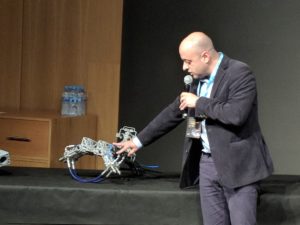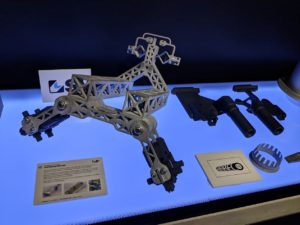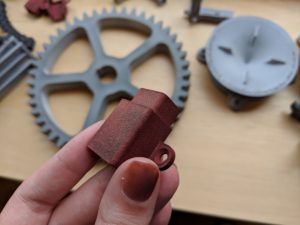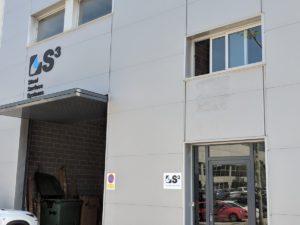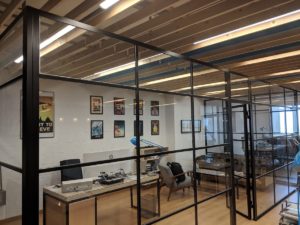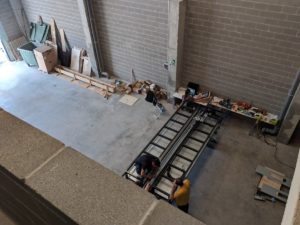 At the recent HP Global Innovation Summit, 3D printing was a major spotlight focus as HP Inc. has made no secret of its ambitious intentions for Multi Jet Fusion’s place in the global manufacturing industry. The technology has seen its star rising with increasing global installations and as the footprint widens, so too do real-world applications.
At the recent HP Global Innovation Summit, 3D printing was a major spotlight focus as HP Inc. has made no secret of its ambitious intentions for Multi Jet Fusion’s place in the global manufacturing industry. The technology has seen its star rising with increasing global installations and as the footprint widens, so too do real-world applications.
During the 3D printing panel at the Global Innovation Summit, HP customers shared in-depth looks at the progress they have made since adopting MJF 3D printing into operations. Among these customers was Nuno Neves, Co-Founder of FICEP S3, and to learn more about his company’s use of 3D printing and strategies, it was a pleasure to sit down with him for an interview — and then go on-site to the company’s location outside Barcelona for an up close and personal look.
At HP’s Barcelona facility, I sat down with Neves and HP’s Vice President, Global Strategy and Business Management, 3D Printing, Alex Monino. Our conversation, also including journalist Simnikiwe Mzekandaba from South Africa, offered a global perspective on the incoporation of additive manufacturing as a strategic business decision.
Neves noted that FICEP is working to “help companies get to where we are now,” offering guidance and growing expertise born of experience to other entities working to adopt advanced technologies for prototyping, assembly, and other applications. Neves brought with him to the Summit a machine arm from the company’s Da Vinci Paint Machine. While this was “the least interesting piece we have, it is the most visual” to showcase the company’s use of the technology, as in creating their machines with 3D printed parts they have been able to eliminate about 2,000 molds previously necessary for production.
“This arm I drew on a train from Paris to Milan. With the original drawing, I had a lot of questions I jotted down,” Neves told us. “The intention was for it to be created with 3D, but it was before HP had Multi Jet Fusion. We were looking to SLS, SLA, and assembling, but none of that would have worked well. We wouldn’t have gotten the strength with this part we have with MJF.”
Multi Jet Fusion was initially released to the market in late 2016, following its official unveiling earlier that year and a few years of announcements teasing HP’s entrance into 3D printing. Neves and his team decided to wait until they could obtain MJF for their operations before embarking on their own 3D printing foray, as everything they learned about the technology indicated that it would be the best fit for their needs. Now, Neves describes MJF as “a great technology, incredibly strong,” adding that, “this is why we started with HP.”
FICEP redesigned their entire machine to take advantage of the advanced capabilities of addiitve manufacturing; “the design is entirely different than what we had three years ago,” Neves noted. Pointing to the arm, he noted that everything seen there could be produced three at a time in a 16-hour print job, with any remaining build area allotted to other parts needed for different projects. Because of the speedier production times, FICEP found that the sale of just one Da Vinci machine paid off the investment into a Jet Fusion 3D printer.
“And now, customers have changed their designs to adapt to this technology,” he continued. “We made a turbine for a customer, a regular wind turbine. It was designed for stamp sheet metal, and I asked if I could redesign it. We’ve saved 23% of energy with the air flow. At a certain RPM it deforms, on purpose, and the air flow doesn’t change.
“This allows you to design freely, which for an engineer is nice. We’re not a service company, we’re an engineering technology company. It’s hard to get industry to adopt the technology because they don’t know about it, they don’t know about what it can do. Having that freedom of design helps us. We only need to show them the part, get them to come see it. As soon as we get them to come, we can get them to adopt this technology.”
I asked Neves about his own introduction to 3D printing, after he mentioned that many people’s first experience with the technology comes from extrusion-based desktop machines. At a charity event about a year and a half ago, he was introduced to additive manufacturing, able to see prototypes and watch the parts actually being produced.
“Sometimes you have an idea in your head and need something to make it click; the charity thing was the click. I didn’t seriously look into other technologies. Briefly SLS; we knew the limits we had with that. It was this material, seeing how these parts come out, their strength. The fact [MJF] can fuse the entire layer at one time gives us incredible mechanical properties,” he said. “With SLS, we would be able to print the geometry — but not with these properties. This is a very strong material, and in any color you want as long as it’s black. We have done it red [in post-processing], which actually comes out a really cool color, and we’re going to try blue.”
The mechanical properties enabled by this technology allow for a lightweight robotic arm that can “stop moving immediately, while with the competition it stops within maybe half a meter” following a given command.
While Neves noted the colors FICEP has worked with, he added that for thier industrial customers, color is not of the primary importance. Darker colors, like black, in fact work better, as “they’ll be touching these parts with a greasy hand, and the darker the color the less you see that.” Other more advanced capabilities than color are more appealing to this team as they keep up on what HP has planned for future technology releases, including looking toward embedding electronics in a part and further building up mechanical properties.
As we had touched on barriers to adoption, I asked what Neves and his team’s own learning curve had been when it came to design for additive manufacturing (DfAM). Rethinking and designing specifically for additive manufacturing requires a different mindset and approach, which the team at HP has been working to ease.
“When we got the machine it was still a pretty new machine; everyone was learning at the same time. There was a lot of dialogue, a lot of experimentation. Now, we are at the point of getting it right the first time — every time. The first five months, we had experiments, seeing how parts come out this way, why they shrink here and expand here, and we developed processes. Now we help others to do that, and eliminate this learning curve for them,” Neves told me.
“You have a learning curve in anything. When you switch material entirely, from metal to this, it’s a major learning curve. Now we try to help our customers to avoid that.”
As the team has become more experienced working with the technology, so too has HP continued to add to the overall ownership experience, Neves noted.
“One surprise was that there are a lot of firmware updates from HP. They keep making it better. With every update, it’s kind of like having a different machine, because now it does this, the process is more optimized. Last week we had a firmware update, which added some new features to interface with the build unit and printer. You do notice it keeps getting better and better with each update,” he said.
To learn more about FICEP S3’s business strategies regarding 3D printing, I took the trip to Vilassar de Dalt to see the company’s installation and operations.
- Neves’ office
The three-level facility started with a focus on structural steel and now focuses exclusively on additive manufacturing, with steel operations having been passed off to partners. Projects and R&D all start at this site, with Neves pointing to a 95-page report for one project as an indicator of the depth they go with each level of detail.
FICEP has been in this facility for one year, as of April, and is a young company in every sense; much of the talent pool comes from nearby universities and one of the oldest employees is 27 years old. In Neves’ view, it is “really important to get fresh engineers, with zero experience, with zero vices.” It’s an important investment to be sure to get the right people to bring about new ways of thinking — and with newer engineers, there are fewer “bad habits” to break from built-up thinking in terms of traditional manufacturing.
“We are thinking openly. 3D allows me to design what I want to design, the way I want to design it,” he said as we walked. “It’s really interesting, we work on a lot of different projects. It lets you do so many things, things you never saw in your life. We have made a part for a liposuction system, a keychain, heat exchangers. It’s always different.”
The FICEP team, of about a dozen people, also participates in mentoring and internship opportunities as Neves continues to focus on developing the next generation of engineers with the latest skill sets. Expansion is also in sight, as the building next door will soon be added to the facility, at which time the production team will expand.
The lower floor, where the 3D printers are housed, is climate- and humidity-controlled, at about 20°C and 50-55% humidity. Starting builds at about the same time every day has led to a regularity in build patterns allowing the team to continue to play and experiment with their setup. One of their team members, Julia, built a warm box for temperature control. The Raspberry Pi-powered box can tell about where each part is cooling and constantly monitor temperatures for control throughout. The build unit goes into this box before being put into fast cooling, Neves explained, adding that “there’s a lot of tech in this wooden box.”
The regular firmware and hardware updates he had mentioned during our sit-down discussion were observable on site. The day before my visit, new fusing lamps had arrived, for example.
“This wasn’t our business model,” Neves said, gesturing at the 3D printer. “But now we’re considering adding another system and three more build units.”
- An older-model desktop machine helps the team introduce 3D printing to kids as well
- Plenty of room for additional installation
Discuss HP, Multi Jet Fusion, the future of manufacturing, and other 3D printing topics at 3DPrintBoard.com or share your thoughts in the Facebook comments below.
[All photos: Sarah Goehrke]
Subscribe to Our Email Newsletter
Stay up-to-date on all the latest news from the 3D printing industry and receive information and offers from third party vendors.
You May Also Like
Precision at the Microscale: UK Researchers Advance Medical Devices with BMF’s 3D Printing Tech
University of Nottingham researchers are using Boston Micro Fabrication‘s (BMF) 3D printing technology to develop medical devices that improve compatibility with human tissue. Funded by a UK grant, this project...
3D Printing Webinar and Event Roundup: April 21, 2024
It’s another busy week of webinars and events, starting with Hannover Messe in Germany and continuing with Metalcasting Congress, Chinaplas, TechBlick’s Innovation Festival, and more. Stratasys continues its advanced training...
3D Printing Webinar and Event Roundup: March 17, 2024
It’s another busy week of webinars and events, including SALMED 2024 and AM Forum in Berlin. Stratasys continues its in-person training and is offering two webinars, ASTM is holding a...
3D Printed Micro Antenna is 15% Smaller and 6X Lighter
Horizon Microtechnologies has achieved success in creating a high-frequency D-Band horn antenna through micro 3D printing. However, this achievement did not rely solely on 3D printing; it involved a combination...



